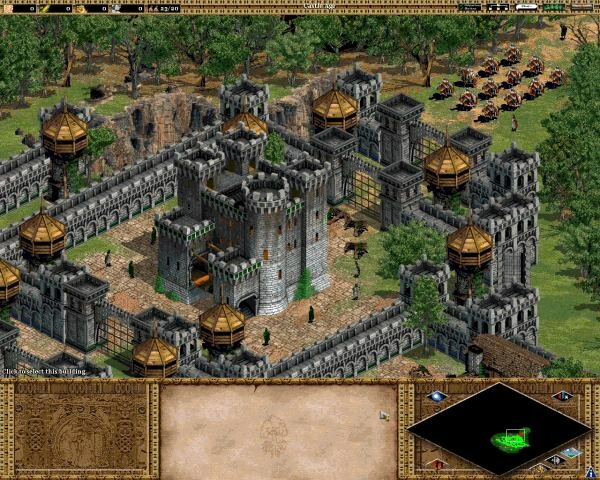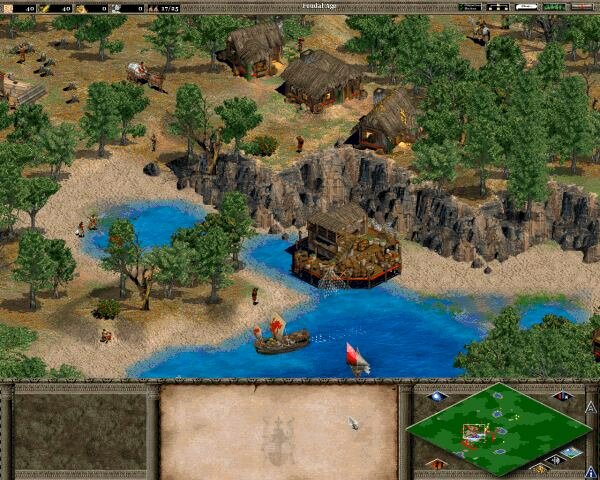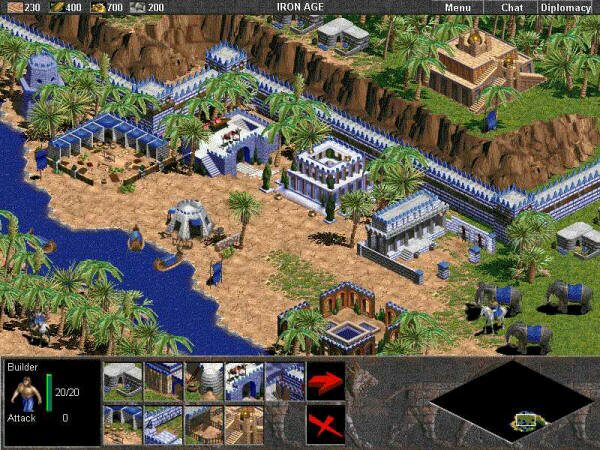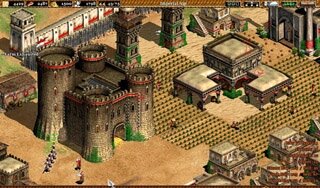 Since AOEII is due out by Fall 2000, Konami will have to work fast to get this game ready to go so I don't think we'll be seeing many new additions. It will most likely be a straight port. It's possible they might be able to add the AOEII expansion pack but chances of that are slim. So anyway, I'll explain a bit about the PC version to give you an idea of what to expect on PS2. Since AOEII is due out by Fall 2000, Konami will have to work fast to get this game ready to go so I don't think we'll be seeing many new additions. It will most likely be a straight port. It's possible they might be able to add the AOEII expansion pack but chances of that are slim. So anyway, I'll explain a bit about the PC version to give you an idea of what to expect on PS2.
It's the middle ages, from the fall of the Roman Empire on to the Emperial Age and gunpowder. This period covers about 1000 years from 500 AD to 1500 AD. It is a real time strategy game of controlling a civilization from its humble beginnings and building it up over time into a world superpower. Anyone interested in European history would find this game fascinating. The PC version has a history section that is basically a book that talks all about the middle ages; societies, cultures, weapons, fighting techniques, religions etc. It's really interesting stuff for history buffs like myself but I found that besides being informative, this section helped draw me into the game more and added a lot to my gameplay experience because it makes you more familiar with the various units and structures in the game. I really hope that this section is included in the PS2 version.
 Like most RTS games, what it boils down to be is a fight for resources. AOE is no different, only instead of harvesting vespene gas or chrystals, the workers (your villagers) hunt, farm and fish for food, gather stone, gold and wood to advance their society. Players can choose from impressive 13 civilizations, which include: Britons, Byzantines, Celts, Chinese, Franks, Goths, Japanese, Mongols, Persians, Saracens, Teutons, Turks and Vikings. All of them have similar units like archers, swordsman and knights and certain technologies are only available to certain civs but in the end they are well balanced. My favorite civ is the Turks just in case you wanted to know. The four main resources you have to collect is food, wood, gold and stone. They are used to build structures like the Town Center, houses, barracks, castles etc. And also for raising your army, researching technologies (like plate armour) for your soldiers and advancing through the ages. In AOEII, you civ starts in the Dark Age. They have it pretty rough, they have nothing but rags to clothe themselves and ramshackle housing and the very basic of technologies. In this age you are very vulnerable as you probably have very little defense other than your local militia which are basically farmers that learned how to swing a stick with a spike at the end. Even a pack of wolves at this point can be a threat! Like most RTS games, what it boils down to be is a fight for resources. AOE is no different, only instead of harvesting vespene gas or chrystals, the workers (your villagers) hunt, farm and fish for food, gather stone, gold and wood to advance their society. Players can choose from impressive 13 civilizations, which include: Britons, Byzantines, Celts, Chinese, Franks, Goths, Japanese, Mongols, Persians, Saracens, Teutons, Turks and Vikings. All of them have similar units like archers, swordsman and knights and certain technologies are only available to certain civs but in the end they are well balanced. My favorite civ is the Turks just in case you wanted to know. The four main resources you have to collect is food, wood, gold and stone. They are used to build structures like the Town Center, houses, barracks, castles etc. And also for raising your army, researching technologies (like plate armour) for your soldiers and advancing through the ages. In AOEII, you civ starts in the Dark Age. They have it pretty rough, they have nothing but rags to clothe themselves and ramshackle housing and the very basic of technologies. In this age you are very vulnerable as you probably have very little defense other than your local militia which are basically farmers that learned how to swing a stick with a spike at the end. Even a pack of wolves at this point can be a threat!
Actually, it doesn't even sound like an RTS game because you aren't building a military base right off the bat. The beauty of this game is that it is very practical and realistic to those middle age times. Like the blacksmith's shop is where technologies are researched, houses support and determine the number of military units you can make. Food can be collected by a variety of means whether it be hunting deer, sheep, wild boar, using fishing nets, foraging for barries, building a dock and fishing ships or farming the land. When you advance to the next age, new units, buildings and technologies will be made available. Also, as you advance, you're structures change from dilapidated huts on to more majestic and well crafted buildings.
 After you've established your barrings in the Dark Age and moved on to the Feudal Age, it would be a good idea to explore the terrain to discover resource areas and of course other potential rival villages. The interesting thing about AOEII is that you don't have to obliterate your opponents to win! No, there are other ways to dominate such as by economic superiority or by constructing a "wonder". Once you advance to the final Empirical Age you will have the technology to build a great Cathedral. Once completed, you need only defend it for a certain period of time and if your foes cannot destroy it, then you win! The awesome thing about this game is that it lets you use many different strategies to win and they are virtually unlimited. You can choose to play offensively by raising a huge army of swordsman, archers, knights, and siege weapons to break into enemy fortresses and lay waste to their towns. However, it's easier said then done. Against a strong civ, you will need large numbers of units and coordinate the attack as well as make use of each unit's advanced controls like formations, and stances. It's quite a sight to see a force of up to 200 units that you've created pour through a section of wall that your trebuchets have created as they catapulted fireballs through the air to dismantle the fortification. It's also fun to play a defensive role, constantly expanding and taking over resources areas and extracting the gold and stone from the ground. Since there are various fortifications such as wood fences, stone walls and watchtowers, you can block off trade routes and resources from other civs and watch them widdle away as they pathetically attempt to attack you. You can even steel their sheep by bringing one of your units close to them or send your military units to kill off herds of boar or deer that your opponent would have used to get food! It's cruel but it works. After you've established your barrings in the Dark Age and moved on to the Feudal Age, it would be a good idea to explore the terrain to discover resource areas and of course other potential rival villages. The interesting thing about AOEII is that you don't have to obliterate your opponents to win! No, there are other ways to dominate such as by economic superiority or by constructing a "wonder". Once you advance to the final Empirical Age you will have the technology to build a great Cathedral. Once completed, you need only defend it for a certain period of time and if your foes cannot destroy it, then you win! The awesome thing about this game is that it lets you use many different strategies to win and they are virtually unlimited. You can choose to play offensively by raising a huge army of swordsman, archers, knights, and siege weapons to break into enemy fortresses and lay waste to their towns. However, it's easier said then done. Against a strong civ, you will need large numbers of units and coordinate the attack as well as make use of each unit's advanced controls like formations, and stances. It's quite a sight to see a force of up to 200 units that you've created pour through a section of wall that your trebuchets have created as they catapulted fireballs through the air to dismantle the fortification. It's also fun to play a defensive role, constantly expanding and taking over resources areas and extracting the gold and stone from the ground. Since there are various fortifications such as wood fences, stone walls and watchtowers, you can block off trade routes and resources from other civs and watch them widdle away as they pathetically attempt to attack you. You can even steel their sheep by bringing one of your units close to them or send your military units to kill off herds of boar or deer that your opponent would have used to get food! It's cruel but it works.
Sometimes instead of one army attacking a fortification, rival armies can meet head on for a wide-open blood bath. It can be an ugly scene unless you are prepared and have a well-balanced force. For example, swordsman excel at attacking hand-to-hand other ground units, but they are vulnerable to the long range of archers (units that fire missile weapons like the bow). So unless you have your own contingent of range units, the swordsman will get slaughtered. Also, some units are very deadly to others such as siege weapons like the onager (fires projectiles like rocks or fireballs from a catapult). This thing can lay out entire waves of forces so you would need to send a quick unit like cavalry out to destroy it. Each civ also has a unique unit that no other civ has. It is created in the castle and is usually one of your most powerful unit and cost effective. For example, the Briton's unique unit is the Longbowman and the unique unit for the Persians is the War Elephant.
 The game modes include campaigns in which you take control of a civ and proceed through a series of missions that actually happened so they are somewhat historically accurate. One of the campaigns lets players join Gengis Khan, leader of the Mongols during their crusade of world domination and you must convince other clans of your race to join you. The random map mode lets you setup a game exactly how you like, pick your opponents and fight it out in a randomly generated map. You never get the same one twice. In Regicide, the players who's King is the last to survive is the winner and the King's live inside the castles so this mode requires different strategies than a regular game. In Deathmath, each player starts with a large stockpile of resources and their society is already in place. You don't have to worry about building up infrastructure, just fighting it out. And of course there is the multiplayer mode. Although this game will be out before the PS2 network goes up, an update for network play is very possible since the game is going to be very successful. It would make a great candidate for being one of the first online games. The game modes include campaigns in which you take control of a civ and proceed through a series of missions that actually happened so they are somewhat historically accurate. One of the campaigns lets players join Gengis Khan, leader of the Mongols during their crusade of world domination and you must convince other clans of your race to join you. The random map mode lets you setup a game exactly how you like, pick your opponents and fight it out in a randomly generated map. You never get the same one twice. In Regicide, the players who's King is the last to survive is the winner and the King's live inside the castles so this mode requires different strategies than a regular game. In Deathmath, each player starts with a large stockpile of resources and their society is already in place. You don't have to worry about building up infrastructure, just fighting it out. And of course there is the multiplayer mode. Although this game will be out before the PS2 network goes up, an update for network play is very possible since the game is going to be very successful. It would make a great candidate for being one of the first online games.
If you are an RTS fan, you will want to grab this game for sure and if you've never played AOEII for PC then you'll be in for a treat. Well assuming that there are no screw-ups in the porting phase but I'm confident that a reputable company like Konami will do an excellent job. Get ready for a huge hit coming this Fall, I sense this one will be very popular.
|
 |
|
Expected Release Date:
Fall 2000
Developer / Publisher:
Ensemble Studios/Konami
Players:
1
|




